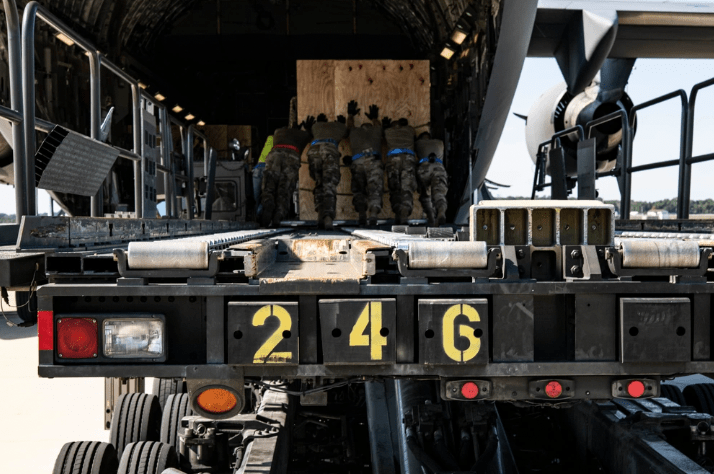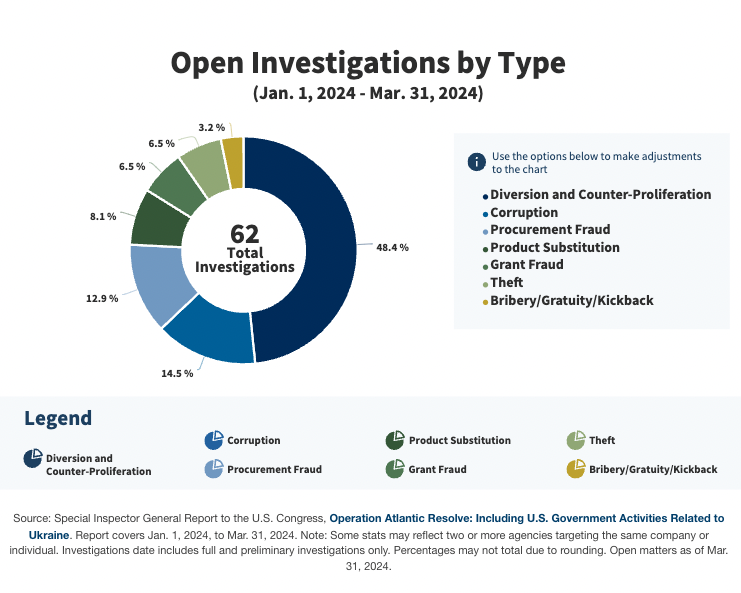Inside the ‘whole-of-government’ approach to watchdogging US assistance to Ukraine

The one-stop, online hub built for Congress and the American public to access the latest official information on U.S. security, economic and humanitarian assistance to Ukraine was recently updated to display new features and an interactive dashboard that tracks completed and ongoing federal oversight projects, three senior officials told DefenseScoop.
This marks the first official redesign for UkraineOversight.gov since it was launched in March by the Pentagon’s Office of the Inspector General in collaboration with IGs for the State Department and U.S. Agency for International Development.
The website hosts a steadily growing arsenal of data and reporting from those three IGs, the Government Accountability Office and other members of the Ukraine Oversight Interagency Working Group. It’s broadly billed as a mechanism to expand transparency around the oversight community’s complex, unfolding pursuits to keep an eye on the use of U.S. taxpayer dollars supporting Ukraine’s response to Russia’s latest full-scale invasion, which began in early 2022.
“The version 2.0 update provides additional details about U.S. funding to Ukraine — such as a breakdown by agency through static and interactive infographics — a new investigations page, and a new homepage,” Haider Mullick, who serves as the director of the Strategic Initiatives Directorate in DOD’s Office of the Deputy Inspector General, told DefenseScoop.
Mullick led the recent website revamp.
In multiple conversations with DefenseScoop over email this week, he and two other leading defense oversight officials (including the Pentagon’s IG Robert Storch) provided new details about the making, elements and significance of UkraineOversight.gov — and how it will continue to evolve from version 2.0.
Roots to revamp
Congress has appropriated approximately $174.2 billion in supplemental funding through multiple channels for U.S. support to Ukraine since Russia invaded the smaller, neighboring nation in February 2022, according to the watchdog site.
Operation Atlantic Resolve emerged in 2014 as a key contingency effort to deter Russian aggression against NATO and foster security assistance activities for Ukraine in response to Russia’s invasion of the Crimea peninsula.
A team led by the Special IG for Operation Atlantic Resolve (SIG-OAR) was formed to conduct, coordinate, prioritize and transparently report the comprehensive oversight for all aspects of U.S. government aid to Ukraine. DOD’s Inspector General Storch was named SIG-OAR on Dec. 22, 2023 — the same day that the National Defense Authorization Act for fiscal 2024 was passed.
“This designation is made in times of extraordinary and temporary situations,” DOD IG Spokesperson Mollie Halpern told DefenseScoop on Tuesday.
Generally, Congress establishes “Special IGs” in response to critical oversight priorities that require focused attention — like foreign conflict and reconstruction situations when significant sums of taxpayer funds are spent and require additional oversight to protect investments from waste, fraud, abuse and mismanagement.
However, “it’s important to note that this is the first time Congress has designated a Lead IG or a sitting IG as a Special IG,” Halpern explained.
Historically, it’s been after Congress has created new Special IG agencies — such as SIGIR (Iraq Reconstruction), SIGAR (Afghanistan Reconstruction), SIGTARP (Troubled Asset Relief Program), etc. — that presidents have appointed new Special IGs to lead them.
“Prior to becoming Special Inspector General, it was announced in this September 2023 press release that IG Storch was named the Lead Inspector General for Operation Atlantic Resolve. The Inspector General Act of 1978, as amended, established the Lead IG framework for oversight of overseas contingency operations,” Halpern said.
After serving as a long-time federal prosecutor and oversight executive in the Public Integrity Section of the Justice Department’s Criminal Division, Storch spent close to five years as the first presidentially appointed, Senate-confirmed IG for the National Security Agency.
He also previously served as a resident legal advisor for the DOJ in Ukraine and provided technical assistance for the U.S. in the drafting and implementation of Ukraine’s anti-corruption legislation, according to his bio.
“I’ve traveled to Kyiv with my oversight partners twice since the full-scale invasion and, having worked and lived there in the past, it’s difficult to see that capital city in a time of war,” Storch told DefenseScoop in an email Wednesday.
His prior experience working on behalf of the U.S. government helping the Ukrainians develop measures to address official corruption has supplied him with what he said is a valuable historical perspective for his current role as the DOD Inspector General and the Special Inspector General coordinating U.S. assistance to Ukraine.
“In this capacity, it is my responsibility to ensure that we get the information we need to protect American security assistance and tax dollars intended to help the Ukrainian people. We have a talented team of oversight professionals, including personnel posted at the Embassy in Kyiv and forward deployed in the region, who conduct both programmatic oversight and investigations, drawing on our deep experience doing this work in conflict situations,” Storch said.
The fiscal 2024 NDAA formally mandated a publicly available website of the U.S. government’s “comprehensive accounting of unclassified amounts” appropriated by the United States for Ukraine.
Storch and members of his team emphasized that the online resource also aligns with the DOD OIG’s “organizational core value of transparency.”
“I’m particularly proud of the efforts of my team and our colleagues in developing UkraineOversight.gov as an interactive, one-stop site that provides transparency to the public regarding our comprehensive oversight work,” Storch told DefenseScoop.
Oversight of U.S. assistance includes both programmatic oversight and investigative activities.
In this case, “the oversight community” refers to the 23 U.S. federal oversight agencies that are members of the Ukraine Oversight Interagency Working Group.
As the lead IGs, officials from DOD, State and USAID identify watchdog projects that examine the economy, efficiency and effectiveness of programs and operations related to a contingency operation — and then collaborate with partner agencies through the working group to promote a whole-of-government approach to oversight.
“This group serves as a primary venue to coordinate audits, inspections, and evaluations of U.S. Government-funded activities supporting the Ukraine response as part of Operation Atlantic Resolve,” Halpern said.
As SIG-OAR, Storch set up a website steering committee with senior representatives from GAO and the offices of State and USAID IGs.
Halpern explained that the steering committee met weekly “to coordinate the design, usability, and content of the website, and share real-time information that enhanced the effectiveness of oversight efforts through sections, such as a dynamic data-driven dashboard of the whole-of-government oversight.”
Officials involved also worked with the Pandemic Response Accountability Committee and Oversight.gov to apply lessons learned and share information regarding the development, testing and management of the site.
“The steering committee continues to propose improvements to UkraineOversight.gov,” Halpern said.
The committee worked closely with the DOD IG to develop and launch the portal in 11 weeks.
“The team secured the .gov domain name from the Office of Management and Budget in two weeks, which usually takes four months. The team then implemented a dynamic oversight dashboard — first of its kind on a DOD website — and added translation services across the website,” she told DefenseScoop.
What’s new
The website categorizes oversight work across three strategic oversight areas including security assistance and coordination, non-security assistance and coordination, and management and operations.
Halpern said the overarching purpose of the online hub “is to enhance Congressional and public transparency of the collective oversight effort across the U.S. government by showcasing analysis of completed and ongoing oversight projects; identifying risk areas; assessing the status of funding; offering hotline links to report fraud, waste, abuse, and corruption; and publicizing congressional testimony, international engagements and more.”
Though they declined to publicly name the company they worked with to develop it, both she and Mullick pointed to the dynamic oversight dashboard as “the first of its kind on a DOD website.”
Defense Media Activity, which administers more than 2,000 websites using the American Forces Public Information Management System, has never implemented the type of dashboard that’s operating on the UkraineOversight.gov site, they said.
“The dashboard is an interactive dataset of completed and ongoing oversight projects performed by oversight agencies. It empowers the visitor to rack and stack oversight work by oversight agency, strategic oversight area, fiscal year, or type of project, such as audit or inspection,” Mullick said. “It provides a user-friendly interface with charts and graphs to break down the data and provide PDF and Excel versions of the completed and ongoing list of oversight projects.”
Viewers can interact with the dashboard by hovering a mouse over donut charts, bar charts and pie charts to see additional information; clicking on those charts to dynamically filter the oversight projects below; or using the column on the right to filter data by fiscal year, strategic oversight areas, agency and other elements.
As part of the 2.0 upgrade, Mullick and his team conducted “a general cosmetic refresh to all the content,” which he said is designed to enhance the user experience and navigation, clarify complex concepts through a more streamlined layout, and break content out into more specific, digestible funding sections.
“It includes more use of video, images, and infographics and less text. Style changes across the website should give it a new feel,” Mullick said.
There’s also a new “Investigations and Hotline” landing page to spotlight efforts by law enforcement from DOD, State and USAID IGs who detect and deter criminals attempting to exploit U.S. government assistance to Ukraine. During the last data reporting period (January-March), the lead IGs established a Ukraine Fraud and Corruption Investigative Working Group to coordinate their investigative efforts with other U.S. and Ukrainian government law enforcement and prosecutorial partners.
“As of the end of last quarter (March 31, 2024), there were 62 open criminal investigations. The open investigations involve grant and procurement fraud, corruption, theft, program irregularities, and diversion or counter-proliferation of technology of weapons systems components,” Mullick said.

Expanding on the latest features, he added: “Another enhancement to the website is the funding page which now includes new static and interactive infographics illustrating the most recent Congressional appropriation, where the funding is going, and what categories each oversight agency controls. The site also delves deeper and breaks down the different types of assistance, such as Foreign Military Financing and PEACE Multi Donor Trust Fund.”
Building on this momentum moving forward, Halpern said, the website will continue to expand as more oversight work is completed and future quarterly reports on Operation Atlantic Resolve are provided to Congress.
“This body of work will add additional data points and context to the complex whole-of-government independent oversight of U.S. assistance to Ukraine. We plan to add dynamic data platforms to promote our oversight projects, U.S. funding, investigations, open recommendations, and hotline links,” she said.
DefenseScoop asked Halpern whether the DOD IG will widen or replicate these efforts to track oversight of other nations’ weapons and security assistance from the U.S. beyond Ukraine — and namely, Israel.
“At this time, there are no plans to copy or expand the website beyond Ukraine,” she said.



